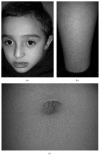Neurological Manifestations of X-Linked Ichthyosis: Case Report and Review of the Literature
- PMID: 28884032
- PMCID: PMC5572599
- DOI: 10.1155/2017/9086408
Neurological Manifestations of X-Linked Ichthyosis: Case Report and Review of the Literature
Abstract
A 5-year-old boy presented with mild autism and attention-deficit hyperactivity disorder (ADHD). Chromosomal microarray demonstrated a 1.7 Mb deletion at Xp22.31, which was consistent with X-linked ichthyosis (XLI). Further exam revealed dry, scaly skin on his abdomen and pretibial areas. Patients with mutations involving solely the STS gene or the recurrent ~2 Mb deletion may present with ADHD, whereas those with larger deletions including the NLGN4 gene can present with both ADHD and autism. However, our patient presented with mild autism in addition to ADHD despite having only the recurrent deletion without loss of NLGN4. Such neurological manifestations of XLI warrant attention as practical targets of clinical management.
Figures


Similar articles
-
X-linked ichthyosis (steroid sulfatase deficiency) is associated with increased risk of attention deficit hyperactivity disorder, autism and social communication deficits.J Med Genet. 2008 Aug;45(8):519-24. doi: 10.1136/jmg.2008.057729. Epub 2008 Apr 15. J Med Genet. 2008. PMID: 18413370
-
A novel nonsense mutation in the STS gene in a Pakistani family with X-linked recessive ichthyosis: including a very rare case of two homozygous female patients.BMC Med Genet. 2020 Jan 31;21(1):20. doi: 10.1186/s12881-020-0964-y. BMC Med Genet. 2020. PMID: 32005174 Free PMC article.
-
Xp22.3 interstitial deletion: a recognizable chromosomal abnormality encompassing VCX3A and STS genes in a patient with X-linked ichthyosis and mental retardation.Gene. 2013 Sep 25;527(2):578-83. doi: 10.1016/j.gene.2013.06.018. Epub 2013 Jun 18. Gene. 2013. PMID: 23791652
-
[X-chromosome-linked ichthyosis associated to epilepsy, hyperactivity, autism and mental retardation, due to the Xp22.31 microdeletion].Rev Neurol. 2012 Feb 16;54(4):241-8. Rev Neurol. 2012. PMID: 22314765 Review. Spanish.
-
X-linked ichthyosis along with recessive dystrophic epidermolysis bullosa in the same patient.Dermatology. 2010;221(2):113-6. doi: 10.1159/000313507. Epub 2010 Jun 4. Dermatology. 2010. PMID: 20523032 Review.
Cited by
-
Placental steroid sulphatase deficiency: an approach to antenatal care and delivery.Ann Saudi Med. 2018 Nov-Dec;38(6):445-449. doi: 10.5144/0256-4947.2018.445. Ann Saudi Med. 2018. PMID: 30531180 Free PMC article.
-
Exploratory case study of monozygotic twins with 22q11.2DS provides further clues to circumscribe neurocognitive markers of psychotic symptoms.Neuroimage Clin. 2019;24:101987. doi: 10.1016/j.nicl.2019.101987. Epub 2019 Aug 17. Neuroimage Clin. 2019. PMID: 31446315 Free PMC article.
-
Cardiac arrhythmia, developmental delay, epilepsy and ichthyosis due to Xp22.31 deletion: review of literature and case report.Transl Pediatr. 2025 Jun 27;14(6):1370-1379. doi: 10.21037/tp-2025-87. Epub 2025 Jun 25. Transl Pediatr. 2025. PMID: 40688208 Free PMC article.
-
X-linked ichthyosis: Molecular findings in four pedigrees with inconspicuous clinical manifestations.J Clin Lab Anal. 2020 May;34(5):e23201. doi: 10.1002/jcla.23201. Epub 2020 Jan 16. J Clin Lab Anal. 2020. PMID: 31944387 Free PMC article.
-
Xp22.31 copy number variations in 87 fetuses: refined genotype-phenotype correlations by prenatal and postnatal follow-up.BMC Med Genomics. 2023 Apr 3;16(1):69. doi: 10.1186/s12920-023-01493-z. BMC Med Genomics. 2023. PMID: 37013593 Free PMC article.
References
-
- Kent L., Emerton J., Bhadravathi V., et al. X-linked ichthyosis (steroid sulfatase deficiency) is associated with increased risk of attention deficit hyperactivity disorder, autism and social communication deficits. Journal of Medical Genetics. 2008;45(8):519–524. doi: 10.1136/jmg.2008.057729. - DOI - PubMed
-
- Ballabio A., Zollo M., Carrozzo R., et al. Deletion of the distal short arm of the X chromosome (Xp) in a patient with short stature, chondrodysplasia punctata, and X-linked ichthyosis due to steroid sulfatase deficiency. American Journal of Medical Genetics. 1991;41(2):184–187. doi: 10.1002/ajmg.1320410210. - DOI - PubMed
Publication types
LinkOut - more resources
Full Text Sources
Other Literature Sources
Miscellaneous

